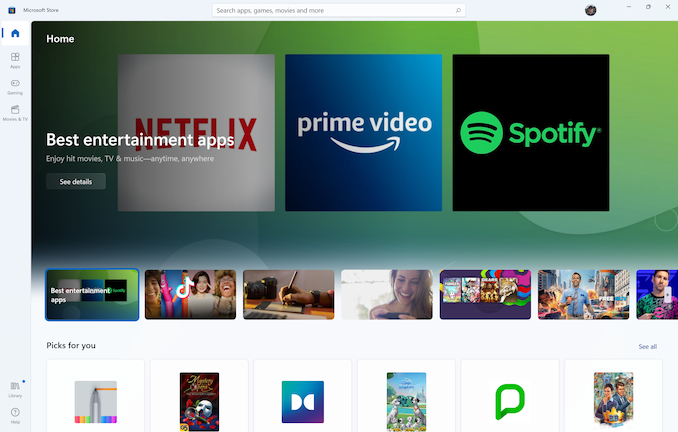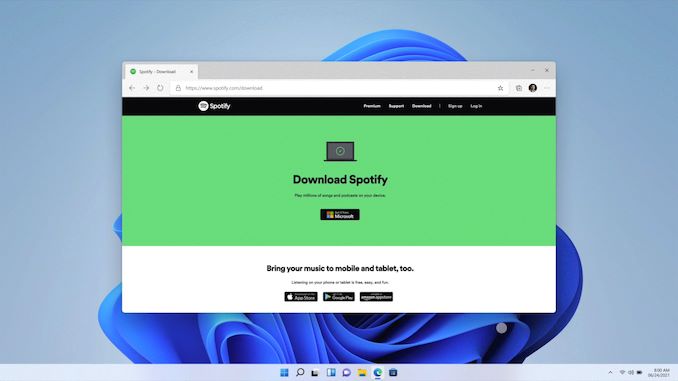What to Expect with Windows 11: A Day One Hands-On
by Brett Howse on October 4, 2021 4:00 PM EST- Posted in
- Software
- Operating Systems
- Windows
- Microsoft
- Windows 11
Microsoft Store
There are some big changes to the Microsoft Store model, although not all of them will be available at launch. Microsoft is dramatically changing their policies on what can go in the store, which should open the store up to more applications. Unlike the user interface changes though, the new store features/policies will be applied to Windows 10 as well.
When the Microsoft Store first appeared in Windows, it forced developers to utilize what eventually became known as Universal Windows Platform applications, or UWP apps. That nomenclature has morphed over time, and eventually Microsoft created methods for developers to publish more traditional Win32 applications in the store as well. The Windows 11 store dramatically expands this, allowing developers to publish any application built in any framework. Win32, .NET, UWP, Xamarin, Electron. React Native, Java, and of course Progressive Web Apps are now all supported frameworks in the store. This should immediately make the store much more useful to all users.
Microsoft is also changing the revenue share that they take from developers, perhaps inspired by some of the angst and anger directed at Apple’s App Store. The revenue share is now 85/15 for the developer for applications, and 88/12 for games. What’s more, if application developers bring their own e-commerce platform to their applications, whether one that is in-house or a third party one, Microsoft will take none of the revenue. In addition, Microsoft will be allowing stores within their store, so for example, Epic Games will be available through the Microsoft Store, but Microsoft will not take any of the revenue from Epic for any games sold. The only exception to these rules are video games distributed through the store – game developers will have to give Microsoft a cut regardless, which is perhaps not too surprising given that games are the single largest source of revenue on any of the app store platforms.
Overall, these are dramatic changes and should help the Microsoft Store be a place where people can actually find the apps they want and need. Which not only simplifies the install for the user, but provides a safety net compared to installing random software off the internet.
To be fair, Microsoft is not making these changes because they are a kind, generous company. They are making these changes to try to help the Microsoft Store compete. If applications do not show up in the store now, there seems to be little more they will be able to do to convince developers.
Android Apps on Windows
One of the biggest announcements for Windows 11 is Android application support, and Microsoft will be partnering with the Amazon App store to provide these applications. The underlying technology to support Android applications will be very similar to the Windows Subsystem for Linux, and will be called the Windows Subsystem for Android.
This is another key play for Microsoft to expand Windows 11 and bring additional functionality. Although Microsoft has supported tablet-style applications in Windows since Windows 8, they have never achieved very much developer support. That being said, Android tablet applications have never taken off in a way that most would have expected – Android tablets are predominantly used as portable TVs, as opposed to productivity devices – so we will have to wait and see if this is as big of a deal as promised.
The bad news is that, like many of the promised features for Windows 11, this is not available on launch day, and is scheduled to be available some time in 2022.
Install Apps from the Web
To simplify the experience, Microsoft will also be supporting a simplified install via pop-up on the web for sites that have apps in the store. This is something that other operating systems already support, but still nice to see.













95 Comments
View All Comments
dullard - Tuesday, October 5, 2021 - link
Those people that value vertical real estate always turn around and by short-screen monitors. They are called wide-screen, but really just have the top vertical pixels chopped off and they charge more for that service.dullard - Tuesday, October 5, 2021 - link
*buy* not *by*emgarf - Tuesday, October 5, 2021 - link
No Start menu icon groups or folders. For those of us with a multi-use PC (in my case it's schematic design and printed circuit board layout, video and audio production, photography, gaming), removing those Start menu organizational features would have a real impact.Windows 10 doesn't force people to use those organizing methods - it's idiocy to remove them as a choice.
TheinsanegamerN - Tuesday, October 5, 2021 - link
Any choice consumers had in 10 is being sandblasted off. You'll use 11 the way redmond wants you to.Meteor2 - Tuesday, October 5, 2021 - link
Seems a year too early to me. Given where we are in the x86 product cycle and the chip shortages, combined with the maximum cpu age restrictions, releasing something that has a main purpose of driving new device sales right now seems premature.Plus, moving the start button out of the bottom left corner. That's going to hurt.
GeoffreyA - Tuesday, October 5, 2021 - link
I wonder which genius at Redmond thought of that.TheinsanegamerN - Tuesday, October 5, 2021 - link
"Tablet Mode is now gone as well, so if you liked to use Windows 10 in its more touch-friendly mode, you will likely be disappointed."So is MS just giving up on tablets, giving surface users the middle finger? Why even bother with the metro/modern/whateverTF they call it interface change if they just go and abandon tablet mode?
GraXXoR - Monday, October 11, 2021 - link
I cloned my SSD and installed Windows 11 update... Apartfrom CFOSpeed network data shaping tool (which has been of limited utility beyond monitoring internet connections and download speeds) I have found no issues.5900x and 3080RTX on gigabyte X570 Aorus Master...
No issues to report. Installed the latest MB bios with TPM2 support. Enabled it. Set the update to run. went to bed. checked my computer the next morning and it was installed.
Plays nicely with grub and my Mint 20.2 installation which I was concerned with what with TPM 2 and all. Interface is more consistent and seemingly refined than W10 and when you remove the "increase spacing" touch bollocks setting, everything is fine.
One noted improvement is with my 42:9 UW monitor. My Samsung Odyssey G9 now plays well with G-Sync (something was borked under W10) and the new full screen tiling feature is a godsend on this ridiculous aspect ratio'd beast. And it seems to play nicely with my secondary monitor
Downside?
The menu is stuck at the bottom which is silly at this aspect ratio and I miss the clock on my secondary monitor's start bar.
I also miss the more functional start menu which has become little more than a glorified right click menu... But TBH, I usually use windows plus search to launch my software anyway.
All in all a drama free update. Will keep my old W10 clone just in case something pops up.
The only reazson I still have this is for games that use anti cheat and have no linux support.
alpha754293 - Monday, October 11, 2021 - link
I would love to be able to try it out, but if TPM 1.2 is a minimum, HARDWARE requirement, then it'll be a while before I will be able to give Win11 a shot.AnnonymousCoward - Wednesday, October 13, 2021 - link
Sounds like Win11 is DOA.Wake me up when Microsoft lets users customize the UI and prioritizes responsiveness with minimal input lag. They have 182,000 employees and can't grasp the most common sense of basic concepts!